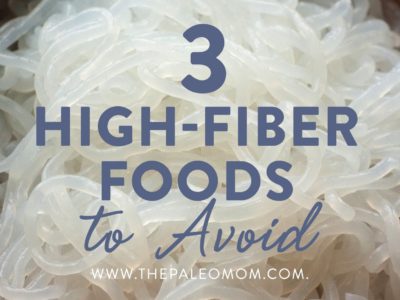Scientific research consistently supports the health benefits of a diet rich in vegetables and fruits. This is in part due to the high vitamin and mineral content of these whole foods (see The Importance of Vegetables) and due to the phytochemicals they contain (see The Amazing World of Plant Phytochemicals: Why a diet rich in veggies is so important! and Polyphenols: Magic Bullet or Health Hype?). There’s another big reason why a veggie-focused Paleo diet promotes health: fiber!
Table of Contents[Hide][Show]
I’ve written extensively about the importance of dietary fiber (see What Is Fiber and Why is it Good?, The Many Types of Fiber, Soluble vs. Insoluble Fiber, Fiber, Cholesterol and Bile Salts, and Busting the Abrasive Insoluble Fiber Myth). However, not all fiber is created equal.
While we can probably agree that grains are problematic (see Why Grains Are Bad–Part 1, Lectins and the Gut, Why Grains Are Bad–Part 2, Omega 3 vs. 6 Fats, and Why Grains Are Bad: Part 3, Nutrient Density and Acidity) and vegetables are fabulous, lately a few other fibers have been sneaking their way into the Paleo world. The fact that something is touted as Paleo doesn’t necessarily mean it’s a great addition to our diet. Let’s take a look at three of these questionable fiber-rich foods and find out why including them in our diets on a regular basis isn’t the best idea.
1. Psyllium Husk
Psyllium husk has long been suggested (think Metamucil) as a treatment for constipation. The husk (the protective layer around the seed) attracts water and becomes gelatinous, thus helping waste move through the colon. It’s even been shown to help lower cholesterol, reduce blood sugar in diabetics, and aid in weight loss. Because of its unique binding properties, I’ve seen it crop up in the Paleo-sphere as way to achieve elasticity in gluten-free and grain-free baking. What’s not to love, right?
But there’s more to the psyllium husk picture, and it isn’t all positive. Mucilaginous fibers like that in psyllium husk can aggravate some gastrointestinal or autoimmune conditions. Since psyllium husk expands when introduced to water, it can cause bezoars—masses of material that obstruct the gastrointestinal tract. There have been cases of small bowel obstruction as well as esophageal impactions associated with psyllium husk consumption. It has also been shown to increase colon cancer progression in people already at risk (see The Verdict on Psyllium Husk: Not Paleo! and Mucilaginous Fiber: The Good, The Bad, and The Gooey). Given that psyillium husk isn’t particularly impressive when it comes to nutrient content, all-in-all, I recommend passing on this as an ingredient (at least for regular consumption) and as a supplement.
2. Potato Starch
Contrary to eating a whole potato, potato starch is usually used as a supplement or baking ingredient in a concentrated powder form. Potato starch is high in resistant starch, a type of fiber that resists being broken down by the digestive enzymes in our small intestine.
Whole food sources of resistant start benefit the gut microbiome by supporting the growth of certain beneficial strains of bacteria, which then ferment the resistant starch and produce beneficial short-chain fatty acids like butyrate. These can have a protective effect and are known to lower risk of colorectal tumors. However, what is often ignored in the discussion surrounding resistant starch is the downside to supplementing with concentrated sources of this substance, rather than getting it from a whole food source (see Resistant Starch: It’s Not all Sunshine and Roses).
Studies show that resistant starch supplementation may increase colorectal cancer growth. This may be due to the fact that isolated resistant starch ferments in the beginning of the colon, without making it to the lower end of the colon. This is a big problem because most often the lower colon is where tumors form. However, those same studies show when resistant starch was introduced as a whole food source, the bulk associated with that food helped carry the fermentation–and beneficial butyrate production–throughout the whole colon. Bottom line: stick with whole food sources of this fiber (yay for starchy veggies), use potato starch sparingly in recipes, and skip the scoops of potato starch in your morning smoothie.
3. Miracle Noodles
These sound awesome, right? “Miracle” foods are always super exciting stuff! Miracle Noodles are generally made up of 3 ingredients: water, calcium hydroxide and glucomannan. Glucomannan is a highly-fermentable soluble fiber composed of a mixture glucose and mannose. Studies have shown glucomannan to have a lot of the same benefits as potato starch. But like potato starch, there may be some downsides to consuming a concentrated source of this fiber (see Are Miracle Noodles Paleo?), namely that glucose and mannose can feed some pretty undesirable bacteria in the gut, with the potential to propel serious infections like C. difficile. Miracle noodles are also a processed/refined food, and are pretty much devoid of nutrients. Though the glucomannan is derived from a tuber called the konjac root which is full of iron, calcium, copper, manganese, and other minerals, Miracle Noodles contains none of that good stuff. While only some of the population may experience actual problems from eating these noodles, there are so many other, better options out there.
The bottom line is that consuming a diversity of fiber types from whole food vegetable and fruit sources, at about 30-50g daily, is optimal for gut microbiome health which influences the health of our entire body. Any concentrated source of fiber, at the very least, has the potential to overfeed only certain species of bacteria in our guts. Even when those species are “good guys”, an imbalance can be a problem. Rather than seeking out fiber supplements, think about each meal containing a few servings of vegetables (even better if they’re each a different color!) covering two thirds to three quarters of your plate (see The Diet We’re Meant to Eat, Part 3: How Much Meat versus Veggies? and Carbs Vs. Protein Vs. Fat: Insight from Hunter-Gatherers).









